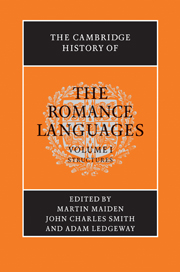Book contents
- Frontmatter
- Introduction
- 1 ROMANCE LINGUISTICS AND HISTORICAL LINGUISTICS: REFLECTIONS ON SYNCHRONY AND DIACHRONY
- 2 SYLLABLE, SEGMENT AND PROSODY
- 3 PHONOLOGICAL PROCESSES
- 4 MORPHOLOGICAL PERSISTENCE
- 5 MORPHOPHONOLOGICAL INNOVATION
- 6 CHANGE AND CONTINUITY IN FORM–FUNCTION RELATIONSHIPS
- 7 MORPHOSYNTACTIC PERSISTENCE
- 8 SYNTACTIC AND MORPHOSYNTACTIC TYPOLOGY AND CHANGE
- 9 PRAGMATIC AND DISCOURSE CHANGES
- 10 WORD FORMATION
- 11 LEXICAL STABILITY
- 12 LEXICAL CHANGE
- 13 LATIN AND THE STRUCTURE OF WRITTEN ROMANCE
- 14 SLANG AND JARGONS
- Notes
- References and bibliographical abbreviations
- Index
5 - MORPHOPHONOLOGICAL INNOVATION
Published online by Cambridge University Press: 28 May 2011
- Frontmatter
- Introduction
- 1 ROMANCE LINGUISTICS AND HISTORICAL LINGUISTICS: REFLECTIONS ON SYNCHRONY AND DIACHRONY
- 2 SYLLABLE, SEGMENT AND PROSODY
- 3 PHONOLOGICAL PROCESSES
- 4 MORPHOLOGICAL PERSISTENCE
- 5 MORPHOPHONOLOGICAL INNOVATION
- 6 CHANGE AND CONTINUITY IN FORM–FUNCTION RELATIONSHIPS
- 7 MORPHOSYNTACTIC PERSISTENCE
- 8 SYNTACTIC AND MORPHOSYNTACTIC TYPOLOGY AND CHANGE
- 9 PRAGMATIC AND DISCOURSE CHANGES
- 10 WORD FORMATION
- 11 LEXICAL STABILITY
- 12 LEXICAL CHANGE
- 13 LATIN AND THE STRUCTURE OF WRITTEN ROMANCE
- 14 SLANG AND JARGONS
- Notes
- References and bibliographical abbreviations
- Index
Summary
Introduction
This chapter explores the relationship between phonological change and inflectional morphology in Romance. It focuses on three types of change whose interaction with morphological structure transcends the familiar scenario whereby alternations produced by sound change lose their phonetically motivated character and then become associated with the expression of morphosyntactic categories. Much of this study will be dedicated to cases in which the originally arbitrary and idiosyncratic nature, from the morphological perspective, of phonetic changes, is not only perpetuated in the morphology long after those changes are extinct, but is replicated and expanded. We enter the realm of paradigmatic structures that ‘do not make sense’, either functionally or phonologically, yet flourish as characteristic patterns in inflectional morphology.
My main concern is with allomorphy in the lexical roots of present tense verbs. This may seem excessively narrow, but amid the profusion of sound changes which have impinged on morphological structure these phenomena stand out, because they reflect phonetic processes ancestral to most Romance languages, but also because they delivered remarkable impetus to subsequent morphological evolution. In short, we shall deal with the emergence of patterns of paradigmatic structure which are highly arbitrary yet constitute a characteristic ‘cut’ (see Sapir 1921:62f.) for Romance morphology.
Recent years have seen growing theoretical interest (e.g., Aronoff 1994; Stump 2001; and, for Italo-Romance, Pirrelli 2000) in the existence of recurrent distributional regularities within inflectional paradigms which cannot be coherently represented, synchronically, either in phonological or functional terms.
- Type
- Chapter
- Information
- The Cambridge History of the Romance Languages , pp. 215 - 267Publisher: Cambridge University PressPrint publication year: 2010
- 4
- Cited by



